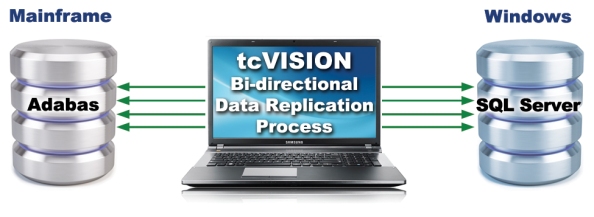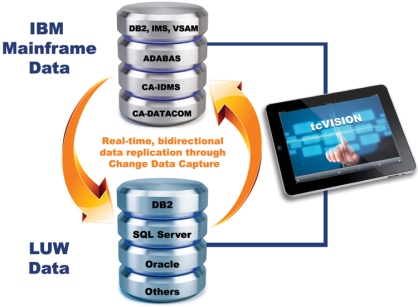Chris Rudolph and Kevin Heimbaugh, Senior Technical Representatives for Treehouse Software, visited a customer site (a large retail and distribution company) to perform a five-day proof of concept (POC) of tcVISION with bi-directional replication between Software AG’s Adabas and Microsoft SQL Server.
Chris and Kevin initially met with the customer team, consisting of the DBA, Applications Manager, and a technical applications person. The agenda for the week was set to:
- Import metadata from several Adabas files
- Bulk load the Adabas data into SQL Server
- Set up replication from Adabas to SQL Server
- Add the bi-directional replication back to Adabas
Additionally, there were a few other items the customer wanted the Treehouse team to address, including support for date formats; timestamps for bi-directional replication to avoid update conflicts; using Predict views to define multiple SQL Server tables; and support for MUs and PEs. Chris noted that everything on the customer’s list is easily supported, and there are several options for the update scenarios that can be used.

After the tcVISION components were installed, the POC began by using tcVISION’s Control Board to define a metadata repository database in SQL Server. Once that was set, the teams moved on to import the first Adabas file’s metadata using tcVISON’s Metadata Import Wizard. As part of this process tcVISION generated Adabas to SQL Server schemas and field-to-column links as well as created target tables in SQL Server. Bulk Transfer scripts were created using a wizard to read the Adabas file on the mainframe, and load the data into SQL Server using the SQL Server bulk loader. Chris created a control script to show how tcVISION can concurrently bulk transfer multiple Adabas files into SQL Server This required increasing the tcVISION Manager’s VSE partition size to successfully test multiple load scripts executing in parallel.
The teams moved on to define the real-time change data capture (CDC) scripts necessary to process the Adabas PLOG. The tcVISION scripts use a two-phase approach to queue captured Adabas transaction on the open platform, then transform and apply the transactions to SQL Server. The scripts were set up to automatically generate detailed logs to track the PLOG transactions captured, SQL statements successfully applied to SQL Server, failed SQL statements, and informational items such as auto-corrected data and transactions rejected due to processing rules.
Now that several tables were defined and loaded, the bi-directional process was set up. SQL Server CDC was enabled for each table to be replicated. The team made a change within SQL Server and verified that the change show up in the SQL Server CDC tables. The SQL Server-to-Adabas mappings were defined in the tcVISION metadata repository, including the “back update check” to ensure only non-tcVISION transactions are captured, and the scripts on both Windows and mainframe were defined to create the LUWs from the SQL Server CDC and apply the changes to Adabas.
CDC from SQL Server to Adabas was successfully tested. Chris then showed the ability to create Journal replication where each change can be captured by replication type. The team spent time creating a few more mappings so multiple file / table updates could be tested, in addition to doing updates while the scripts were stopped to simulate a lost connection. This included setting up a new script to process copied PLOG datasets created by the ADARES utility.
The team defined the remainder of their Adabas files to the metadata repository. Some were set them up for bi-directional replication, and others were setup for unidirectional replication and Journal replication. Everything work as expected at the wrap-up meeting where the team provided a live demonstration to management of tcVISION and the items accomplished. The final tcVISION presentation and demo went very well, and everyone was pleased with the progress made during the week.
Find out more about tcVISION — Enterprise ETL and Real-Time Data Replication Through Change Data Capture
tcVISION provides easy and fast data migration for mainframe application modernization projects and enables bi-directional data replication between mainframe, Linux, Unix and Windows platforms.

tcVISION acquires data in bulk or via change data capture methods, including in real time, from virtually any IBM mainframe data source (Software AG Adabas, IBM DB2, IBM VSAM, IBM IMS/DB, CA IDMS, CA Datacom, even sequential files), and transform and deliver to virtually any target. In addition, the same product can extract and replicate data from a variety of non-mainframe sources, including Adabas LUW, Oracle Database, Microsoft SQL Server, IBM DB2 LUW and DB2 BLU, IBM Informix and PostgreSQL.

Visit the Treehouse Software website for more information on tcVISION, or contact us to discuss your needs.






